Top 10 Treasures of National Museum of China
If you’re an archaeology buff, you should not miss the National Museum of China at the east side of Tiananmen Square. The museum has many precious and rare artifacts not to be found in museums anywhere else in China or the rest of the world. Here are the 10 must-see objects of National Museum of China. If you go to Beijing, you really should pay a visit to these great treasures.
1. Si Mu Wu Ding 司母戊鼎
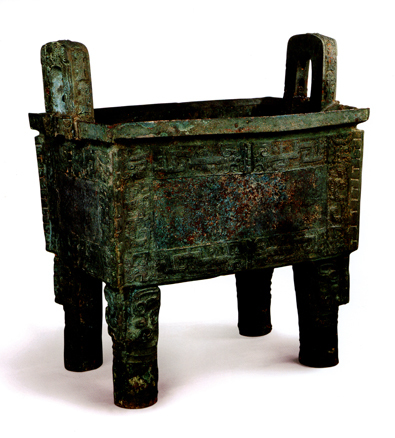 Si Mu Wu Ding is a cooking vessel from Late Shang Dynasty (1400-1100 BC). The vessel was spotted by farmers in a small village near Anyang, in Henan province, March 1939. Weighing 832.84 kg, it is the largest and heaviest of all bronze vessels unearthed to date. It was cast for King ZuGeng or ZuJia of Shang to offer sacrifice to his mother. It demonstrates the technical level of bronze casting in the Shang Dynasty.
Si Mu Wu Ding is a cooking vessel from Late Shang Dynasty (1400-1100 BC). The vessel was spotted by farmers in a small village near Anyang, in Henan province, March 1939. Weighing 832.84 kg, it is the largest and heaviest of all bronze vessels unearthed to date. It was cast for King ZuGeng or ZuJia of Shang to offer sacrifice to his mother. It demonstrates the technical level of bronze casting in the Shang Dynasty.
2. Si Yang Fang Zun 四羊方尊
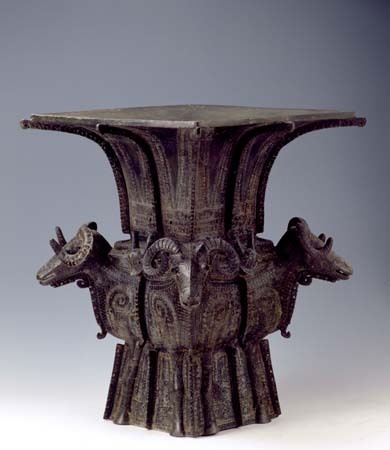 Si Yang Fang Zun is a bronze wine cup of Late Shang Dynasty. It was unearthed from Yueshanpu village, Ningxiang county, Hunan Province in 1938. It is a quadripod carved with four goat-heads and symbolized the huge wealth and distinguished status.
Si Yang Fang Zun is a bronze wine cup of Late Shang Dynasty. It was unearthed from Yueshanpu village, Ningxiang county, Hunan Province in 1938. It is a quadripod carved with four goat-heads and symbolized the huge wealth and distinguished status.
3. Tang Sai Cai Qi 唐三彩骑驼乐舞俑
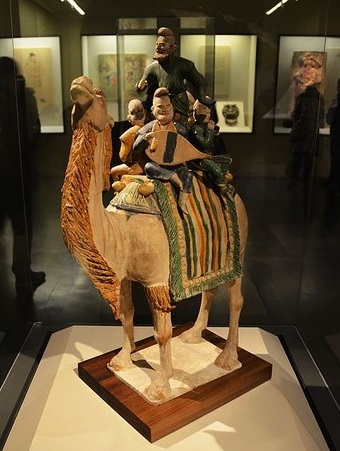 Tang Sai Cai Qi is a pottery figurine of a dancer and musicians riding a camel dating back to Tang Dynasty (618-907 AD). It was unearthed in Xi’an, Shaanxi in 1957. With yellow, white and green as the basic glaze, it is famous for vivid form and bright color. It reflects the China’s economic and cultural exchanges with foreign nations and minorities during the Tang Dynasty.
Tang Sai Cai Qi is a pottery figurine of a dancer and musicians riding a camel dating back to Tang Dynasty (618-907 AD). It was unearthed in Xi’an, Shaanxi in 1957. With yellow, white and green as the basic glaze, it is famous for vivid form and bright color. It reflects the China’s economic and cultural exchanges with foreign nations and minorities during the Tang Dynasty.
4. Jin Lu Yu Yi 金缕玉衣
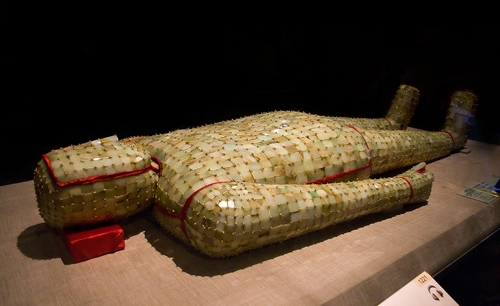 Jin Lu Yu Yi is an ancient jade suit sewn with gold thread. It’s the oldest of China’s jade suits with a history of over 2,000 years. It belonged to Liu Sheng (Prince Jing of Zhongshan) and is made of 2,498 pieces of jade, with more than 1kg of gold thread, and took 100 craftsmen more than two years to complete. It caused an international sensation when it was discovered in 1968.
Jin Lu Yu Yi is an ancient jade suit sewn with gold thread. It’s the oldest of China’s jade suits with a history of over 2,000 years. It belonged to Liu Sheng (Prince Jing of Zhongshan) and is made of 2,498 pieces of jade, with more than 1kg of gold thread, and took 100 craftsmen more than two years to complete. It caused an international sensation when it was discovered in 1968.
5. Hongshan Jade Dragon 红山玉龙
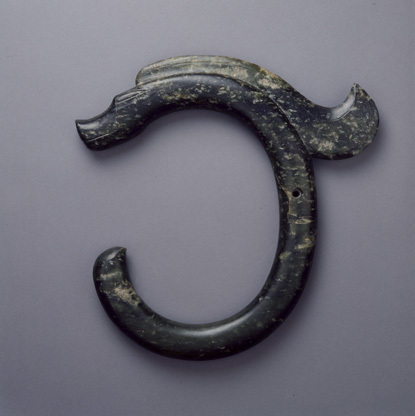 With a history of 8,000 years, Hongshan Jade Dragon is called as the “No. 1 Dragon of China.” The C-shaped jade dragon was unearthed in Hongshan Mountain (Red Mountain), Chifeng City, Inner Mongolia. The dragon’s whole body is curly, holding its mouth high; hair is dancing with wind. This craft reflects the jade art development peak of China’s jade in the primitive society.
With a history of 8,000 years, Hongshan Jade Dragon is called as the “No. 1 Dragon of China.” The C-shaped jade dragon was unearthed in Hongshan Mountain (Red Mountain), Chifeng City, Inner Mongolia. The dragon’s whole body is curly, holding its mouth high; hair is dancing with wind. This craft reflects the jade art development peak of China’s jade in the primitive society.
6. Tomb Figurine of a Storyteller 东汉击鼓说唱俑
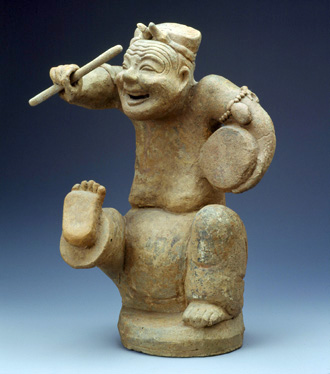 Tomb figurine of a storyteller, a craft from East Han Dynasty (25-220) was excavated in 1957 from tomb Tianhuishan, Chengdu, Sichuan Province. This is a joyous piece, filled with humor and a spirit, bringing to life a performing artist of 2000 years ago.
Tomb figurine of a storyteller, a craft from East Han Dynasty (25-220) was excavated in 1957 from tomb Tianhuishan, Chengdu, Sichuan Province. This is a joyous piece, filled with humor and a spirit, bringing to life a performing artist of 2000 years ago.
7. Basin Painted with Human Head and Fish Design 彩陶人面鱼纹盆
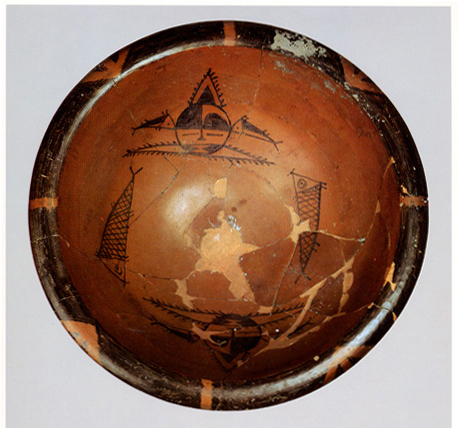 This is a treasure of the Neolithic Yangshao Culture (5000-4000 BC). It was excavated in 1955 from Banpo, Xian, Shaanxi Province. Made from fine red clay, this basin was designed to hold water and painted with a human face and multiple fish.
This is a treasure of the Neolithic Yangshao Culture (5000-4000 BC). It was excavated in 1955 from Banpo, Xian, Shaanxi Province. Made from fine red clay, this basin was designed to hold water and painted with a human face and multiple fish.
8. Green Glazed Vase Covered with Lotus Designs 青瓷莲花尊
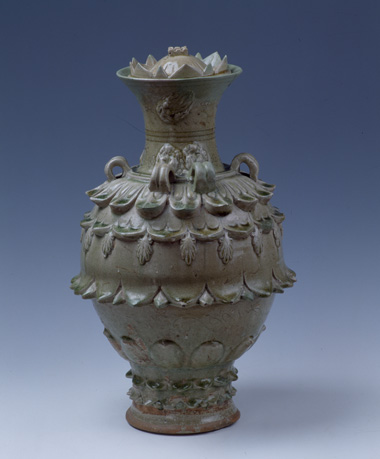 This porcelain masterpiece is from Northern Qi(550-577). It was excavated in 1948 from Feng family tombs, Jingxian, Hebei Province. It is one of the very few ceramics extant from the Northern Qi period and is an unrivalled piece for the study of ceramic production and design in the Northern dynasties period.
This porcelain masterpiece is from Northern Qi(550-577). It was excavated in 1948 from Feng family tombs, Jingxian, Hebei Province. It is one of the very few ceramics extant from the Northern Qi period and is an unrivalled piece for the study of ceramic production and design in the Northern dynasties period.
9. Guojizibai water vessel (pan) 虢季子白盘
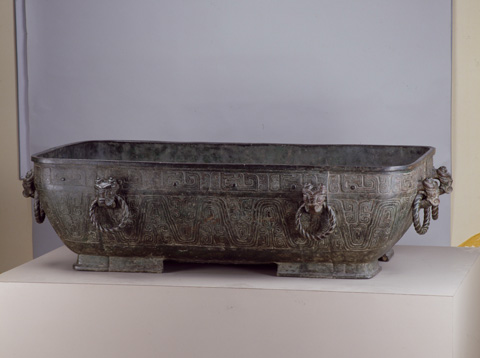 The pan is a water vessel in common use from the late Western Zhou period (c. 9th century – 771 BC). It was excavated in the Daoguang reign period (1821–50) at Baoji, Shaanxi Province. This piece is famous as the largest pan extant from the pre-Qin period.
The pan is a water vessel in common use from the late Western Zhou period (c. 9th century – 771 BC). It was excavated in the Daoguang reign period (1821–50) at Baoji, Shaanxi Province. This piece is famous as the largest pan extant from the pre-Qin period.
10. Jar Showing a Stork with a Fish and a Stone Axe 彩绘鹳鱼石斧图陶缸
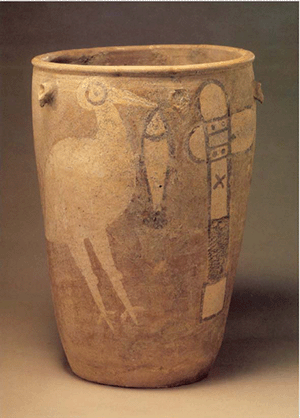 This craft belongs to the Yangshao Neolithic Culture (5000-3000 BC). It was excavated in 1978 from Yancun, Linruxian, Henan Province. The craft reflects the hunting and fishing lifestyle of the peoples of that time, and it is a rare and valuable example of painted pottery from that period.
This craft belongs to the Yangshao Neolithic Culture (5000-3000 BC). It was excavated in 1978 from Yancun, Linruxian, Henan Province. The craft reflects the hunting and fishing lifestyle of the peoples of that time, and it is a rare and valuable example of painted pottery from that period.


Hello I have a silk paint embroidery herding hors by Han Gan Chinese artis I want to sell it . If you are interested in please contact me . My name is mahasti and Iam living in Canada